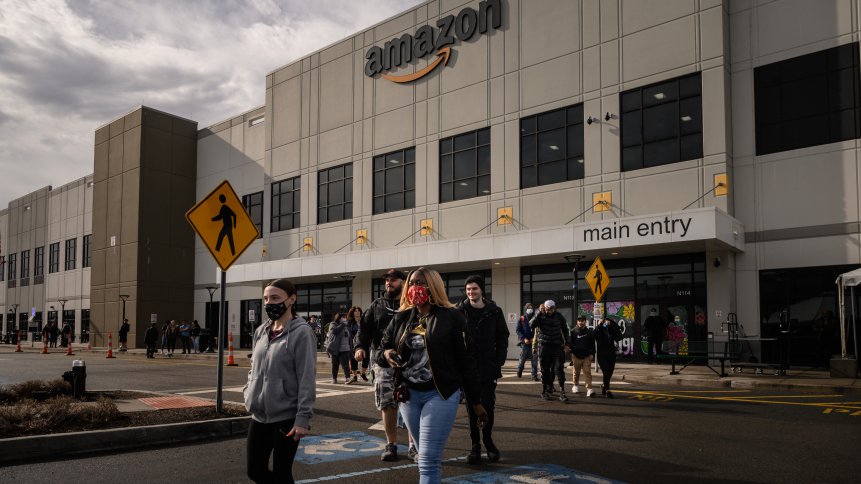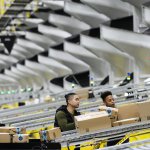Half of US warehouse injuries in 2021 was at Amazon — can automation help?

Workers walk to cast their votes over whether or not to unionize, outside an Amazon warehouse in Staten Island. (Photo by Ed JONES / AFP)
Nearly half of all recorded injuries in US warehouses last year occurred at Amazon, according to a report released this week by a coalition of unions. The e-commerce giant has boomed during the pandemic with soaring home delivery demand, but has also faced criticism over workers’ conditions and its labor practices.
“Amazon employed one-third of all warehouse workers in the US, but it was responsible for nearly one-half (49%) of all injuries in the warehouse industry,” according to the report by the Strategic Organizing Center (SOC).
The SOC report said US Amazon workers sustained more than 34,000 “serious injuries” on the job last year, a rate more than twice as high as that at warehouses not owned by the company.
Amazon acknowledged an increase in the number of injuries as tens of thousands of employees joined its workforce, but argued the rate at which its people got hurt had declined. “Like other companies in the industry, we saw an increase in recordable injuries during this time from 2020 to 2021 as we trained so many new people,” the company said.
NEW REPORT: Amazon promised to be “Earth’s Safest Place to Work,” but our new report shows that injury rates at its facilities increased by a staggering 20 percent in 2021. (1/11)#ProtectAmazonWorkershttps://t.co/rXNW1jhU5y pic.twitter.com/otfUY7JMbE
— Strategic Organizing Center (@TheSOC) April 12, 2022
“However, when you compare 2021 to 2019, our recordable injury rate declined more than 13% year-over-year,” it added.
The coalition of unions, meanwhile, said it relies on data provided by Amazon to the US Occupational Safety and Health Administration — the federal agency responsible for preventing workplace injuries. “After relaxing some of its discipline systems in the first months of the Covid-19 pandemic, Amazon reimplemented its monitoring systems and production pressures in late 2020, and its injury rates rose substantially,” the SOC said.
Hiring at Amazon has spiked during the pandemic. In the United States, the company has gone from some 700 sites in 2020 to more than 900 in 2021, and from more than 200,000 employees in 2017 to over 560,000 in 2021, according to the report.
In June 2021, Amazon changed working conditions, including longer breaks for its workers who prepare, ship, and deliver packages. That decision came after a previous damning SOC report, and an attempt to unionize at an Amazon warehouse in Alabama. That failed, but the campaign exposed what many employees described as the company’s intense pace.
Amazon workers in New York have voted to launch the first US union at the e-commerce giant, an underdog upset against a company that has steadfastly opposed organized labor in its massive workforce.
“We need a better vision for our employees’ success,” wrote Amazon founder Jeff Bezos in an annual letter to shareholders in 2020. “We are going to be Earth’s Best Employer and Earth’s Safest Place to Work,” he promised.
But “in stark contrast to Jeff Bezos’ recent pledge[…] the injury rate at Amazon facilities increased by 20% between 2020 and 2021,” the SOC said.
Automation the obvious answer to mitigating Amazon warehouse injuries
Safety concerns have always plagued the warehouse sector – one of the reasons that fully automated warehousing would appeal to business owners, despite the potential impact to human workers. Fortunately newer technologies are constantly being innovated, and the warehouse safety space is not being overlooked for these crucial concerns.
In fact, Amazon is one of the largest adopters of warehouse automation for precisely this purpose — not to replace human workers and lower costs that way, but as a conduit to ease worker injuries when dealing with the more dangerous, mundane tasks that can stand to be automated rather than expend more valuable human resources.
This level of robotic process automation (RPA), robotics, and algorithms will help streamline automate-able processes to enable Amazon — the largest single employer within the logistics warehouse sector since 2020 — fulfillment center supervisors to better manage their dozens-to-hundreds of frontline floor workers more effectively.
Automation is streamlining the company’s workflows both back of house and in front of the consumer, even introducing wholly automated retail locations. But Amazon needs to ramp up its warehouse and fulfillment center automation pronto to start mitigating the outsized amount of worker injuries the industry leader faces in comparison to competitors.
© Agence France-Presse
6 March 2024










